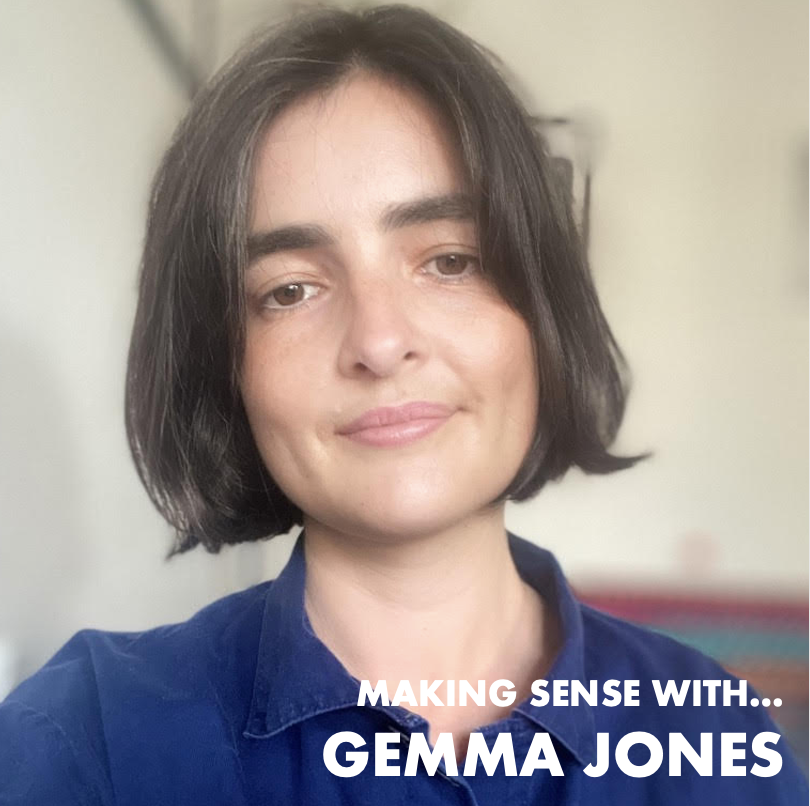Photo courtesy of Gemma Jones
What makes a semiotician tick? SEMIOVOX’s Josh Glenn has invited his fellow practitioners in the field of commercial semiotics, from around the world, to answer a few revealing questions.
Amsterdam…
SEMIOVOX
When you were a child/teen, how did your future fascination with symbols, cultural patterns, interpreting “texts,” and getting beneath the surface of daily life manifest itself?
GEMMA JONES
I grew up an only child in an arty environment — some of my earliest memories are of going to art college after school with my mum and her student friends. I’d watch her painting these larger-than-life representations of things like scissors, surgical instruments, bits of lingerie, buttons — I loved these mundane objects and it made a lot of sense to me that she’d obsess over them and trawl car boot sales to find these treasures. Pop culture was something really celebrated and prized in our home. We didn’t have a TV with lots of channels but whenever I stayed with a friend who had MTV I’d get up early and watch hours of music videos. I remember thinking a lot about the different visual worlds being created around stars and genres, especially hip hop — which seemed like a world away and totally magic.
SEMIOVOX
Describe your first encounter(s) with the theory and practice of semiotics.
GEMMA JONES
I haven’t had formal training in semiotics but I did study literature, film, and later a bit of visual culture, so semiotic theory was always there in different guises. Semiotic practice asks you to bring together so many different kinds of text, to make sense of an idea as a living thing. That is really exciting.
SEMIOVOX
How did you find your own way to doing semiotics?
GEMMA JONES
I wasn’t looking for it! While studying I crossed paths with Space Doctors and the rest is history. The ‘thing’ I wanted to do was curate and write — but without a specialism (or the means to do endless unpaid museum internships), commercial semiotics turned out to be a beautiful way to use those urges — to observe, theme, tell stories about big and small ideas.
SEMIOVOX
What are the most important attributes of a good semiotician?
GEMMA JONES
- You have to really love the world — in the sense that you really want to pay attention to it.
- Being an anti-snob helps: Everything is or can be significant and worthy of our time.
- Playing nice with other methods and research practitioners — semiotics is so agile, it’s helpful to be prepared to function within interdisciplinary teams and approaches.
SEMIOVOX
What three books about semiotics have you found the most useful and enlightening in your own work?
GEMMA JONES
I loved reading Berger’s Ways of Seeing and Barthes’ Mythologies — I found them passionate and fun. Reading Baudrillard on simulacra and simulation during my first year at uni was a trip.
I read a lot of fiction as a way to immerse myself in different cultural contexts and meaning systems.
SEMIOVOX
When someone asks you to describe what you do, what is your “elevator pitch”? How do you persuade a skeptical client to take a chance on using this tool?
GEMMA JONES
I’ll talk about setting a foundation of cultural intelligence and sensitivity. Making the complexity of popular culture legible and picking up on nuances that can make or break an experience. I might talk about how efficient the outputs can be — accelerating consumer insights to somewhere creative and generative.
SEMIOVOX
What specific sorts of semiotics-driven projects do you find to be the most enjoyable and rewarding?
GEMMA JONES
I love decoding places. I’ve used semiotics within place-making and spatial design projects and that’s really thrilling for me. The overlapping temporalities, behaviours, and cultural systems in a place really unlocks the potential of semiotics.
Using semiotics as a means to help us re-value material culture moves me too — recently I worked with my team at Protein on a multi-market study of future materials. Understanding the emergent codes of materiality in fashion to push beyond the hygiene factors and empty metrics dominating much of the category today. The semiotics component really inspired the client-side R+D team who had a great love and reverence for the materials they work with; semiotics gave them a rich emotional and cultural language for this.
SEMIOVOX
What frustrates you about how semiotics is practiced and/or perceived, right now?
GEMMA JONES
I think perceptions of the discipline need to move beyond the staples of branding — packaging, advertising, naming, etc. I’d love to see semiotics ‘pointed’ at the necessary shifts we need to see in culture, helping all types of communicators bring new kinds of stories to the surface.
SEMIOVOX
What advice would you give to a young person interested in this sort of work?
GEMMA JONES
Don’t be intimidated by big language and the old guard. Connect with the community, attend Semiofest events, take your local semiotician out for coffee. There’s so much love and support for new practitioners and the semio-curious. The semiotics community needs you; you have a new take on emergent cultural spaces that we might not even have heard of yet.
And just get stuck in. There’s no one way or perfect method. Borrow some of the frames, ask some semiotic questions of any brief you’re working on. It’s likely to be useful, and it will definitely be fun.
MAKING SENSE series: MARTHA ARANGO (Sweden) | MACIEJ BIEDZIŃSKI (Poland) | BECKS COLLINS (England) | WHITNEY DUNLAP-FOWLER (USA) | IVÁN ISLAS (Mexico) | WILLIAM LIU (China) | SÓNIA MARQUES (Portugal) | CHIRAG MEDIRATTA (India / Canada) | SERDAR PAKTIN (Turkey / England) | MARIA PAPANTHYMOU (Greece / Russia) | XIMENA TOBI (Argentina) | & many more.
Also see these series: COVID CODES | SEMIO OBJECTS | MAKING SENSE | COLOR CODEX


